|
The purpose of this
column is to provide a look back at various departments and
apparatus from the 1940’s to 1980. From comments made here and on
the Code 3 Bulletin Board, it does appear that there is strong
interest in classic apparatus and historical features, so please
help out by digging out some pictures and historical information and
e-mailing it to me for additional “alarms”.
My father was a member of
the Irvington NJ Department for thirty-four years,
joining the department in 1949, rising to the rank of captain, and
retiring
in 1983. For him, the job was a calling, the only job he ever really
wanted.
He enjoyed the camaraderie of the department, the action of a
"worker", and
most importantly, he liked helping people. His last years were spent
as
training officer, passing on the valuable lessons he had learned
over his
career to a new generation of firemen. Had I been as fearless as he
was when
it came to heights, I would have followed in his boots, but that was
not to
be. Instead, I have a collection of pictures from his time on the
job, along
with a lot of terrific memories of visiting the various houses to
which he
was assigned. As an introduction to this column, I will share with
you some
pictures of the IFD and it's apparatus from the time period when my
Dad was
on the job. I would like to thank the following people for helping
to make
this column possible: Larry Lorance, for supporting my idea; Ken
Martin and
Mike Martinelli for their generous support (both verbal and
photographic)
and inspiration; and Chief Don Huber of the Irvington Fire
Department, who
not only is a good fireman but a good friend. Finally I'd like to
dedicate
this column to my Dad, who was a good fireman and an even better
father who
never forgot to give an extra pull on the airhorn as he rolled past
our
house to another box.
Irvington is a small town in geographic size-only 3 and Ѕ square
miles-but
it was (and still is) densely populated. A suburb of Newark,
Irvington
featured a mix of middle and lower class residential neighborhoods
along
with commercial and industrial areas.The Irvington Fire Department
was
formed in 1894, and became a paid department in 1904. It has the
distinction
of not only having the first piece of motorized apparatus in the
state (a
Knox combination engine), but the IFD was the first completely
motorized
department in the state. The fire load has always been quite heavy,
and
there have been some spectacular jobs from the time period we are
looking
at:
Solondz Lumber Yard, 1961
The Feld Lumber Yard, April 1967
Club Navajo, August, 1967
Keller Warehouse & New Jersey Charcoal, October, 1967
Canadian Furs, October 1967
Olympic Park, 1969
Seaboard Plastics & Roofing, 1972
First up is a rig that I
don’t recall, but it was in service when my Dad was first on the
job, so here it is: a 1941 American LaFrance JOX 75’ aerial that
was originally Truck 1. Here it is pulling out of Station 2 on Coit
Street.
Click on any photo to enlarge
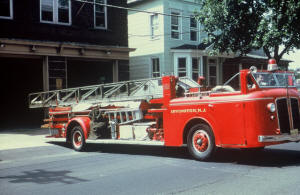
Next up is Reserve Engine 1, a 1948
American LaFrance engine with a 1000 GPM pump and a 150 gallon tank. At
one time, this rig was apparently painted white, but was redone in
red.

Another reserve, this one RE-4. It is a 1943
Mack, 750GPM/150. How about that European style striping on the
bumper?!
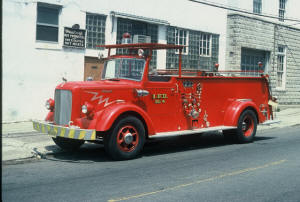
One that features both Engine 1 (before it was
relegated to reserve status) and the Squad, this version a Mack C.
The Squad was the busiest unit in the department, rolling on all
full alarms and on any emergency calls. This picture was taken at
the old Station 1 on Washington Avenue, and the house is no longer
standing. At the wheel of the Squad is my father, which
makes me think that this picture was probably taken prior to 1961,
which is when he was promoted to captain.
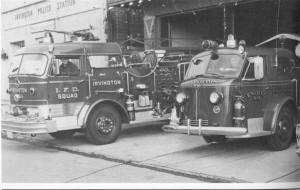
The successor to the ALF JOX from above, this
is a 1955 Pirsch with an 85’ ladder. In the first picture it is at
Station 1 on Civic Square, and in the second it is outside the
department’s training facility.
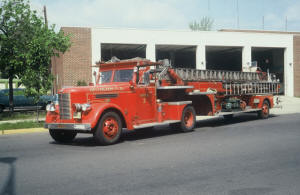
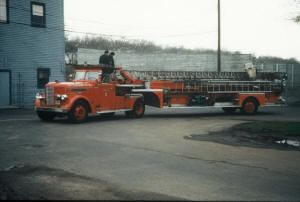
This concludes Part I of this
retrospective—Part II will feature more Macks, some Ward LaFrances,
and rigs from several other manufacturers. Let me know what you
thought of the pictures and article, and send in your own “Second
Alarm” photos and information for publication.
Part 1
| Part 2 |
Part 3 |
Part 4 |
Part 5 |

